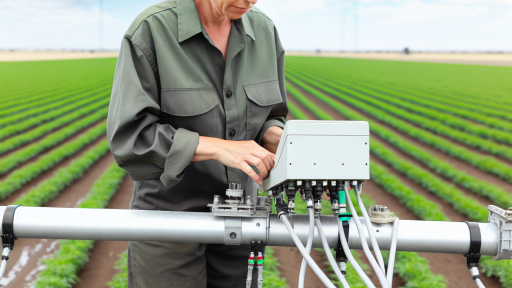Introduction to Robotic Farming
Overview of Robotic Farming
Robotic farming represents a significant shift in agricultural practices.
It combines technology with traditional farming methods.
Many farmers now rely on automation to increase efficiency.
These robots perform various tasks such as planting, weeding, and harvesting.
Advantages of Robotic Farming
One main benefit is improved efficiency in farming operations.
Robots can work tirelessly, day and night.
This availability increases productivity significantly.
Additionally, robotic systems reduce labor costs for farms.
Farmers can allocate resources to other essential areas.
Precision and Sustainability
Robotic farming enhances precision in crop management.
These systems deliver the right amount of water and nutrients.
As a result, they minimize waste and environmental impact.
Moreover, robotic farming supports sustainable agricultural practices.
This approach helps conserve natural resources during cultivation.
Data Collection and Analysis
Robots equipped with sensors gather valuable data from fields.
Transform Your Agribusiness
Unlock your farm's potential with expert advice tailored to your needs. Get actionable steps that drive real results.
Get StartedThis data provides insights into soil health and crop performance.
Farmers can make informed decisions based on real-time analytics.
Consequently, data-driven methods contribute to higher yields.
Challenges of Implementing Robotic Farming
Despite its advantages, robotic farming comes with challenges.
Initial investment costs for robotics may be high.
Training staff to operate and maintain these systems is important.
Access to technology and infrastructure can also be limiting factors.
Future of Robotic Farming
The future of robotic farming looks promising and innovative.
Advancements in technology are making these systems more accessible.
This evolution allows for the growth of both small and large farms.
Ultimately, robotic farming paves the way for a new era in agriculture.
Assessing Current Team Skills and Identifying Gaps
Current Skill Assessment
Begin by evaluating each team member’s skills and knowledge base.
Use a skills matrix to categorize abilities relevant to robotic farming.
Include both technical and soft skills in your assessment.
For example, programming skills are essential in operating robotic systems.
Furthermore, communication skills facilitate teamwork and collaboration.
Performing Skills Inventory
Create a comprehensive inventory of skills possessed by your team.
Documentation helps identify strengths and areas needing improvement.
Use surveys or interviews for gathering individual skill data.
Encourage team members to self-assess their competencies honestly.
This information will drive your training focus and investments.
Identifying Skills Gaps
Compare your team’s skills against the requirements of robotic farming.
Look for discrepancies such as emerging technology knowledge.
Identify gaps in operational understanding of robotics.
Showcase Your Farming Business
Publish your professional farming services profile on our blog for a one-time fee of $200 and reach a dedicated audience of farmers and agribusiness owners.
Publish Your ProfileRecognize the need for training in data analytics and machine learning.
These areas will enhance efficiency and productivity.
Developing a Training Roadmap
Once gaps are identified, create a tailored training roadmap.
Prioritize skill development based on farming goals and technology integration.
Incorporate various training methods, such as workshops and online courses.
Additionally, include hands-on experience with robotic systems.
This multifaceted approach fosters deeper understanding and application.
Developing a Training Program
Setting Objectives
Begin by defining clear training objectives.
Focus on skills that empower your team.
Additionally, align objectives with company goals.
Consider the specific technologies in use.
Ensure objectives are measurable and achievable.
Creating the Curriculum
Draft a detailed curriculum that covers essential topics.
Include hands-on training sessions for practical experience.
Additionally, integrate theory with real-world applications.
Topics should include robotic operation and maintenance.
Furthermore, address safety protocols and troubleshooting techniques.
Incorporating Different Learning Styles
Recognize that team members have varied learning preferences.
Utilize a mix of instructional methods to engage everyone.
Consider visual aids for visual learners.
Hands-on workshops benefit kinesthetic learners.
Moreover, offer reading materials for those who prefer self-study.
Regular Assessment and Feedback
Implement regular assessments to gauge understanding.
Use quizzes and practical tests as evaluation tools.
Provide constructive feedback to encourage improvement.
Additionally, solicit feedback from trainees to refine the program.
Continuously update the curriculum based on feedback and emerging technologies.
See Related Content: Smart Irrigation Systems Powered By Robots
Hands-On Training: Practical Sessions with Robotic Equipment
Introducing Robotic Technology
Robotic technology revolutionizes the farming industry.
First, it automates labor-intensive tasks.
Second, it enhances efficiency and productivity.
Finally, it minimizes human error.
Setting Up Practical Sessions
Begin by organizing practical training sessions.
Choose a suitable location with access to robotic equipment.
Ensure the area is safe and conducive for learning.
Gather a diverse team with varying skill levels.
Rotate responsibilities to promote hands-on experience.
Training Modules
Develop training modules tailored for different roles.
Include basics of robotic operation and troubleshooting.
Offer specialized sessions for maintenance and programming.
Showcase Your Farming Business
Publish your professional farming services profile on our blog for a one-time fee of $200 and reach a dedicated audience of farmers and agribusiness owners.
Publish Your ProfileIncorporate real-life scenarios to enhance problem-solving skills.
Evaluate each module for effectiveness and clarity.
Utilizing Expert Guidance
Engage experienced trainers for practical demonstrations.
Invite robotics engineers to provide insights into equipment.
Encourage questions during each session for better understanding.
Use feedback from participants to improve training methods.
Evaluating Progress
Regularly assess the competency of team members.
Conduct practical tests to gauge understanding of techniques.
Utilize peer reviews to foster a collaborative learning environment.
Provide constructive feedback to help individuals grow.
Continuous Learning and Adaptation
Emphasize the importance of ongoing education in robotics.
Encourage team members to stay updated on industry trends.
Utilize online resources and workshops for further growth.
Foster a culture of innovation through regular brainstorming sessions.
Learn More: Energy Efficient Vertical Farming Techniques for Farmers
Understanding Robotics Software
Introduction to Robotics Software
Robotics software forms the backbone of modern agricultural technology.
It integrates hardware with intelligent automation to optimize farming tasks.
Understanding this software is crucial for anyone in robotic farming.
Key Types of Robotics Software
Robotics software can be broadly categorized into several types.
- Control software manages the operations of robotic systems.
- Simulation software allows testing designs before real-world implementation.
- Data analysis software helps interpret data collected by robots.
Each type plays a unique role in achieving efficiency and accuracy.
Popular Platforms and Frameworks
Various platforms and frameworks facilitate the development of robotics software.
ROS, or Robot Operating System, is widely used in research and industry.
Its community support provides extensive resources for developers.
Other notable platforms include V-REP and Gazebo for simulation.
Choosing the right platform depends on project requirements and team skills.
Tutorials and Learning Resources
Numerous tutorials and online courses are available to aid learning.
Websites like Coursera and Udacity offer courses on robotics programming.
YouTube channels also provide step-by-step video tutorials for beginners.
Utilizing these resources helps build a solid foundation in robotics.
Collaboration and Knowledge Sharing
Engagement with the robotics community fosters knowledge exchange.
Participating in forums and attending workshops enhances learning opportunities.
Collaboration leads to shared insights and innovative ideas in robotic farming.
Uncover the Details: Automated Machinery for Precision Agriculture

Safety Protocols and Best Practices in Robotic Farming
Importance of Safety Protocols
Safety protocols are essential in robotic farming environments.
They protect both workers and machinery.
Moreover, they reduce the risk of accidents.
Ensuring safety fosters a secure working atmosphere.
Training for Safety Compliance
Begin with comprehensive training sessions.
Educate employees about robotic machinery operations.
Include information on emergency procedures and protocols.
Showcase Your Farming Business
Publish your professional farming services profile on our blog for a one-time fee of $200 and reach a dedicated audience of farmers and agribusiness owners.
Publish Your ProfileRegular drills ensure readiness for unexpected situations.
Personal Protective Equipment
Using personal protective equipment is critical in farming.
Ensure that all employees wear suitable gear.
Include helmets, gloves, and safety goggles as essentials.
Regularly inspect and maintain protective gear for effectiveness.
Daily Safety Checks
Conduct daily safety checks before starting operations.
Inspect robotic machinery for any faults or damages.
Verify that all safety features function correctly.
Document findings to maintain a safety record.
Emergency Response Plan
Establish a thorough emergency response plan.
This plan should outline procedures for various scenarios.
Identify assembly points and emergency contacts.
Regularly review and update the response plan as needed.
Continuous Education and Improvement
Encourage continuous education about safety practices.
Provide updates on new safety regulations and technologies.
Invite experts for safety workshops and training sessions.
Foster a culture that prioritizes safety at all levels.
Uncover the Details: Satellite Imagery Applications in Agriculture
Creating a Culture of Continuous Learning and Adaptation
Encouraging Individual Growth
Individual growth enhances overall team performance.
Encourage employees to pursue relevant courses.
Provide access to online training platforms.
Foster an environment that values curiosity.
Recognize and reward personal achievements.
Team-Based Learning Initiatives
Team-based initiatives create synergy and collaboration.
Organize regular workshops to share knowledge.
Utilize case studies to enhance practical understanding.
Facilitate peer-to-peer learning sessions.
Promote brainstorming sessions to solve challenges.
Integrating Technology into Training
Technology plays a vital role in modern training.
Incorporate virtual reality for immersive experiences.
Use online simulations to replicate real-world scenarios.
Leverage mobile apps for on-the-go learning.
Ensure all team members are tech-savvy.
Feedback Loops for Continuous Improvement
Feedback fosters an adaptive learning environment.
Implement regular feedback sessions after training.
Encourage open communication about learning experiences.
Utilize surveys to gauge training effectiveness.
Adjust training based on team input and results.
Establishing a Vision for the Future
A clear vision guides the training process.
Define long-term goals for robotic farming skills.
Showcase Your Farming Business
Publish your professional farming services profile on our blog for a one-time fee of $200 and reach a dedicated audience of farmers and agribusiness owners.
Publish Your ProfileEnsure alignment with industry advancements.
Promote a growth mindset among team members.
Share success stories to inspire motivation.
Evaluating Training Effectiveness
Importance of Feedback
Feedback plays a crucial role in assessing training effectiveness.
It provides insights into how well the training aligns with goals.
Moreover, employee input helps identify strengths and weaknesses.
Ultimately, this information guides future training initiatives.
Methods for Collecting Feedback
Various methods exist for collecting feedback from team members.
Surveys and questionnaires are popular tools for gathering opinions.
Interviews offer a more in-depth understanding of individual experiences.
Focus groups can stimulate discussions among participants.
Therefore, combining these methods yields comprehensive insights.
Analyzing Feedback for Improvement
After collecting feedback, analysis is essential for improvement.
Identify common themes to determine training effectiveness.
Look for trends that indicate areas needing enhancement.
Additionally, consider both quantitative and qualitative data.
This balanced approach facilitates informed decision-making.
Implementing Changes Based on Feedback
Once analysis is complete, implement necessary changes.
Adjust training content to address identified gaps.
Consider introducing new methods or technologies if needed.
Furthermore, keep communication open during this process.
This ensures that team members feel heard and valued.
Continual Evaluation and Adaptation
Training does not end after the initial implementation.
Continuous evaluation ensures that training remains relevant.
Regular assessments will help adapt to changes in technology.
Stay informed about industry trends to enhance training programs.
Ultimately, this commitment to improvement fosters team growth.
Additional Resources
Farm robotics startups face a talent shortage. Academia and tech …
Precision Agriculture in the Digital Era: Recent Adoption on U.S. Farms




